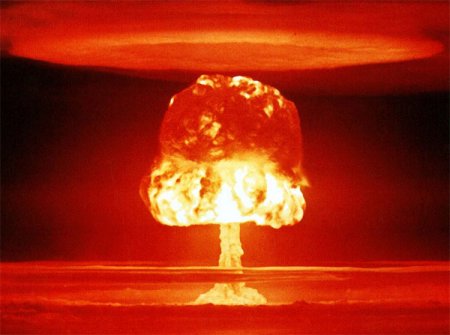 |
| Castle Romeo was a lithium-deuteride fueled H-bomb exploded 1 March 1954 at Bikini Atoll. It yielded 15 megatons and had a fireball 4 miles in diameter. |
PAKISTAN HAS DOUBLED THE SIZE OF ITS NUCLEAR ARSENAL. Now, over 100+ warheads. According to Karen DeYoung at the Washington Post,
Pakistan's nuclear arsenal now totals more than 100 deployed weapons, a doubling of its stockpile over the past several years in one of the world's most unstable regions, according to estimates by nongovernment analysts.
The Pakistanis have significantly accelerated production of uranium and plutonium for bombs and developed new weapons to deliver them. After years of approximate weapons parity, experts said, Pakistan has now edged ahead of India, its nuclear-armed rival.
The Pakistanis have significantly accelerated production of uranium and plutonium for bombs and developed new weapons to deliver them. After years of approximate weapons parity, experts said, Pakistan has now edged ahead of India, its nuclear-armed rival.
How Pakistan became nuclear is an intricate, somewhat sordid tale of corruption and murder and American involvement, and a lot of it is 'deep black' — we may never know who did what to whom. But the Pakistanis and the Indians continue to add to their stock-piles, and should be well on the way to doing 3-stage thermonuclear (H-bomb) designs by now. But even sub megaton warheads can sure lower the price of real estate, and India and Pakistan are acquiring enough "throw weight" to really louse-up their part of the world.
While continuing to produce weapons-grade uranium at two sites, Pakistan has sharply increased its production of plutonium, allowing it to make lighter warheads for more mobile delivery systems. Its newest missile, the Shaheen II, has a range of 1,500 miles and is about to go into operational deployment, Kristensen said. Pakistan also has developed nuclear-capable land- and air-launched cruise missiles.
So, there are 200+ nuclear warheads and a growing parade to a Plutonium Paradise. A giant, steaming bowl of Not Good. If global warming means that water dries up in the north of the Indian sub-continent, where India and Pakistan are contending over Kashmir, things could get crunchy in the next decade or so, as things dry up. But, seriously folks, here's Randy's take from 40 years ago, for a little mood music:

No comments:
Post a Comment